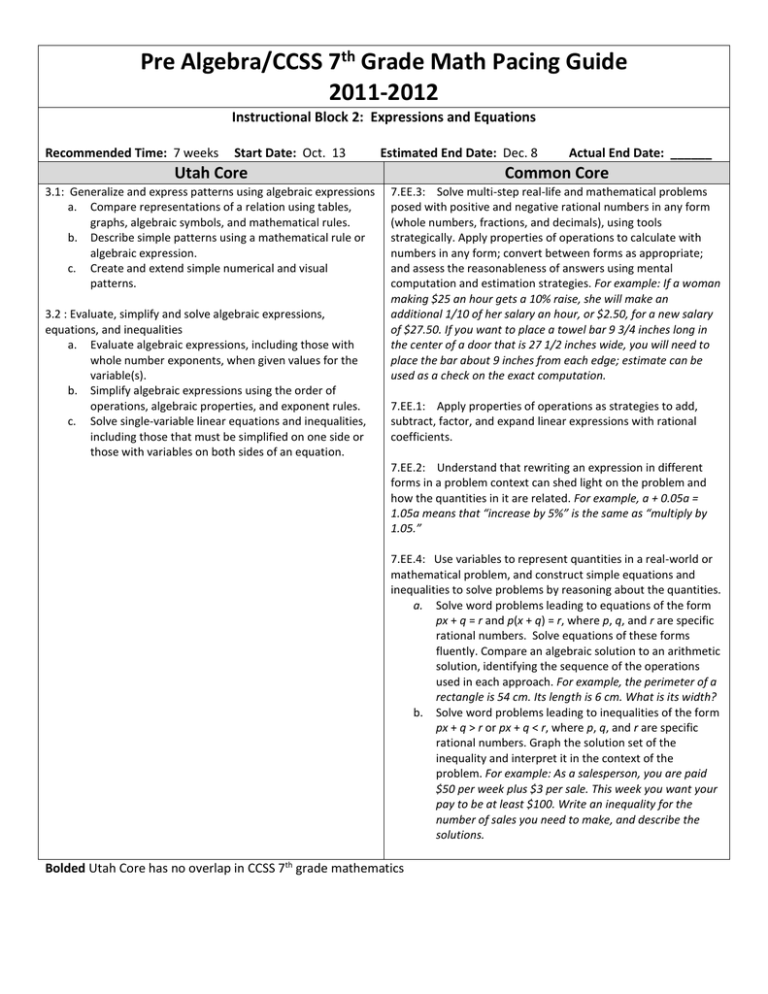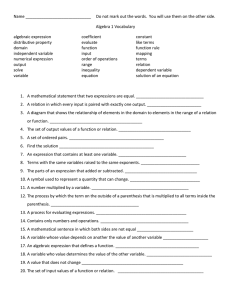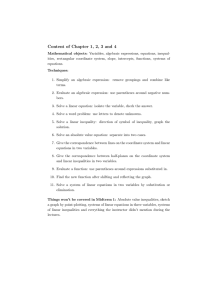Block 2 Pacing Guide
advertisement

Pre Algebra/CCSS 7th Grade Math Pacing Guide 2011-2012 Instructional Block 2: Expressions and Equations Recommended Time: 7 weeks Start Date: Oct. 13 Estimated End Date: Dec. 8 Actual End Date: ______ Utah Core Common Core 3.1: Generalize and express patterns using algebraic expressions a. Compare representations of a relation using tables, graphs, algebraic symbols, and mathematical rules. b. Describe simple patterns using a mathematical rule or algebraic expression. c. Create and extend simple numerical and visual patterns. 7.EE.3: Solve multi-step real-life and mathematical problems posed with positive and negative rational numbers in any form (whole numbers, fractions, and decimals), using tools strategically. Apply properties of operations to calculate with numbers in any form; convert between forms as appropriate; and assess the reasonableness of answers using mental computation and estimation strategies. For example: If a woman making $25 an hour gets a 10% raise, she will make an additional 1/10 of her salary an hour, or $2.50, for a new salary of $27.50. If you want to place a towel bar 9 3/4 inches long in the center of a door that is 27 1/2 inches wide, you will need to place the bar about 9 inches from each edge; estimate can be used as a check on the exact computation. 3.2 : Evaluate, simplify and solve algebraic expressions, equations, and inequalities a. Evaluate algebraic expressions, including those with whole number exponents, when given values for the variable(s). b. Simplify algebraic expressions using the order of operations, algebraic properties, and exponent rules. c. Solve single-variable linear equations and inequalities, including those that must be simplified on one side or those with variables on both sides of an equation. 7.EE.1: Apply properties of operations as strategies to add, subtract, factor, and expand linear expressions with rational coefficients. 7.EE.2: Understand that rewriting an expression in different forms in a problem context can shed light on the problem and how the quantities in it are related. For example, a + 0.05a = 1.05a means that “increase by 5%” is the same as “multiply by 1.05.” 7.EE.4: Use variables to represent quantities in a real-world or mathematical problem, and construct simple equations and inequalities to solve problems by reasoning about the quantities. a. Solve word problems leading to equations of the form px + q = r and p(x + q) = r, where p, q, and r are specific rational numbers. Solve equations of these forms fluently. Compare an algebraic solution to an arithmetic solution, identifying the sequence of the operations used in each approach. For example, the perimeter of a rectangle is 54 cm. Its length is 6 cm. What is its width? b. Solve word problems leading to inequalities of the form px + q > r or px + q < r, where p, q, and r are specific rational numbers. Graph the solution set of the inequality and interpret it in the context of the problem. For example: As a salesperson, you are paid $50 per week plus $3 per sale. This week you want your pay to be at least $100. Write an inequality for the number of sales you need to make, and describe the solutions. Bolded Utah Core has no overlap in CCSS 7th grade mathematics



